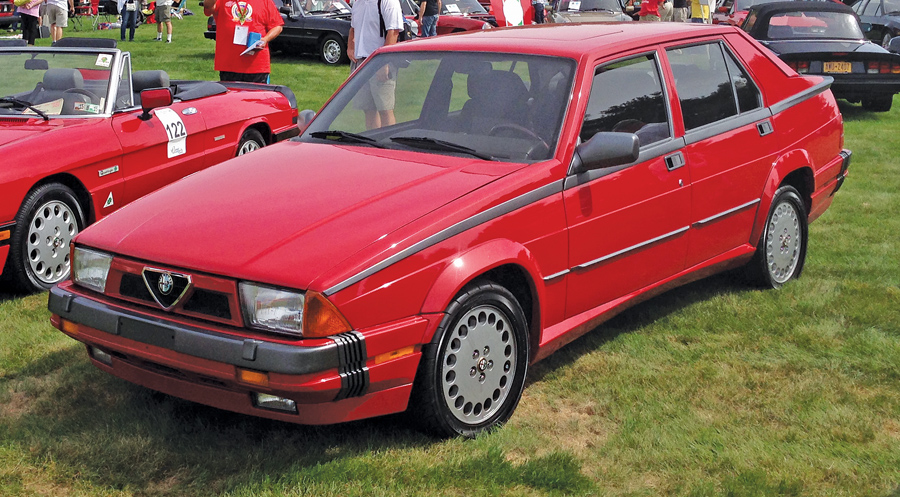No chassis number available
Picture a sunny summer afternoon on the Pacific Coast Highway north of Santa Cruz, CA. It’s the late 1980s, and two new sport sedans are cruising to the spot where a passing lane opens up.
The challenge is to be ahead of the other car by the end of that passing lane. The contestants are a Saab 900 Turbo driven by your humble narrator and a 2.5-liter Alfa Romeo Milano driven by a friend who shall go nameless, even though the statute of limitations has long since expired on this particular exhibition of speed.
In three tries, the Alfa won every time. Maybe a Porsche 944 could have bested the Milano in that acceleration contest. A Corvette almost certainly could have done it. But comparing apples to apples, the Milano was quite a hot rod in its day. Which makes me wonder why the Milano has never attained the kind of respect that other Alfa sedans have received.
The road to the Milano
With the exception of the venerable Alfa Spider, all American-spec Alfas received a very forward-looking change in 1975. The upgrade moved the transmission to the rear of the car. If you’ve never experienced a rear-transaxle Alfa on a racetrack or autocross course, they’re incredibly well balanced and predictable — because of near-perfect front-to-rear weight distribution.
In the 1980s, Alfa brought out a single-overhead-cam V6 engine. First released for the GTV-6 as a 2.5-liter unit, this engine also powered the first Milanos in the 1987 model year. The Alfa V6 engine is a free-revving unit eager to give you everything it’s got, and the 2.5-liter was measured at 154 horsepower and 152 pound-feet of torque.
For 1988, Alfa added the Verde trim with a larger, 3-liter V6 rated at 183 horses and 184 pound-feet. The 3-liter engine was first equipped with Bosch L-Jetronic fuel injection, but Alfa later adopted Bosch Motronic engine management and bumped the 3-liter engine to 189 horsepower and 184 pound-feet. Motronic-equipped cars are designated QV for Quadrifoglio Verde.
Options and quirks
The Milano was available with your choice of a 5-speed manual transmission or an automatic, depending on the model. Milano QV cars were all manuals, and they received a limited-slip differential. Your 0–60 mph time in a Milano QV is about 7.5 seconds, with a top speed around 140 mph.
There are some additional peculiarities to the Milano’s design.
Most notably, the rear brakes are mounted inboard, just on either side of the transaxle. The design reduces unsprung weight in the rear, helping the Milano achieve that excellent handling, but it doesn’t really improve braking performance. Milano owners report that working on those brakes is “a bloody pain in the ass.”
Of course, no classic car is perfect.
The Bosch fuel injection used on the Milano relies on a plethora of tiny vacuum hoses to run right. Get a crack or a leaky end in any one of those, and you’re staring down a difficult troubleshooting process. At 30-plus years of age, you can count on every one of those little hoses being as dry and brittle as a stick of store-bought Capelli d’Angelo.
There was also the looks issue. While the Giugiaro-designed GTV-6 is just about the best-looking hatchback you ever saw, the Milano is kind of a blocky sedan. It certainly didn’t look anywhere near as racy as my black-on-black 3-door Saab.
Prices and values
In its day, the Milano was a premium model with economy pricing. In 1987 the well-equipped Milano Silver trim carried a base price of $12,850, and the top Platinum trim retailed for $18,995.
The base BMW 325 of the same year was priced at $21,475, and the Saab 900 Turbo came in at $20,405. By the end of the import run in 1989, the Milano Gold was still undercutting the competition at $18,475, while the Verde sold for $22,700.
Prices on top Milanos have only just started to trend upwards.
The GTV-6 has become collectible in the past few years, with prices for a good car topping $10,000. But you can still get a nice Milano Verde for well under $5,000.
At bringatrailer.com, a 1988 Verde sold for $3,751 in January 2016. A 1989 Verde sold for $3,600 in March of this year. The SCM Pocket Price Guide lists median money for the Milano at $4,000 (less $1,000 for an automatic) and $6,200 for a Verde.
The best reason to buy any Milano is to drive it.
These Alfas are inexpensive upscale Italian cars that offer good performance, and they don’t attract undue attention from police or thieves. They are inexpensive to insure at this point, even if they’re not the cheapest or easiest cars to maintain.
With renewed interest in Alfa sedans courtesy of the new Giulia, collectors could soon be recognizing the Milano as an Affordable Classic. ♦
Jeff Zurschmeide
Jeff is a lifelong automobile enthusiast with a penchant for sports and racing cars. He has raced SCCA, local circle track, and stage rally as a co-driver. He makes his living as a freelance automotive journalist and is the author of six books on automotive topics. As a rule, he practices catch-and-release fishing when it comes to collectible automobiles, trying to leave each one in better condition than he found it. Enduring passions include his MGA and Austin Mini, and his 1969 Corvette. He recently purchased a 1920 Ford Model T Touring because “you just have to have one of these once in your life.”

